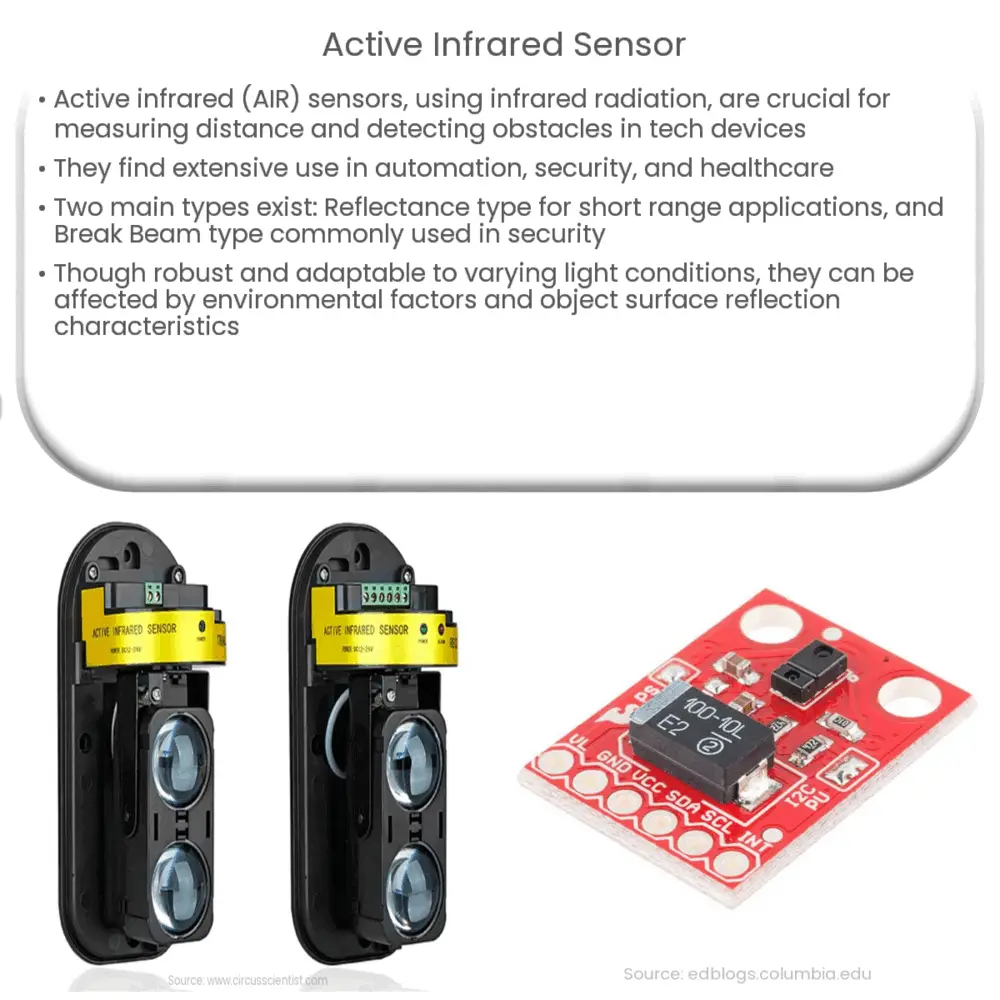Explore the workings of active infrared sensors, their types, applications, advantages, and factors to consider during selection.

Introduction to Active Infrared Sensors
Active infrared sensors, often abbreviated as AIR sensors, are critical components in various technological devices and systems, functioning primarily as distance measurement and obstacle detection tools. These sensors use the principle of infrared radiation, which is invisible to the human eye but can be detected by specialized equipment.
How Active Infrared Sensors Work
In an AIR sensor, an infrared transmitter emits an infrared signal into the environment. The sensor then waits for the signal to bounce back after hitting an object. By measuring the time it takes for the signal to return, the sensor can calculate the distance between it and the object. This process is known as time of flight measurement.
Applications of Active Infrared Sensors
- Automation: AIR sensors are widely used in automation systems. They can detect the presence or absence of an object without any physical contact, making them ideal for conveyor systems, counting products, or positioning.
- Security: Infrared sensors are common in security systems. They can detect motion or the breaking of an infrared beam, triggering an alarm.
- Healthcare: In healthcare, AIR sensors are used in touchless soap dispensers, automatic faucets, and some types of thermometers.
Advantages and Disadvantages of Active Infrared Sensors
Active infrared sensors come with a host of advantages. They are reliable, unaffected by color or material of the object, and can work in various lighting conditions. However, they also have some disadvantages. For instance, they can be affected by environmental factors like dust, fog, and rain. Additionally, they might not function optimally if the object’s surface does not reflect infrared light well.
Types of Active Infrared Sensors
Active infrared sensors are categorized based on their operational principle into two major types:
- Reflectance Type: These sensors measure the reflection of the infrared signal from the object surface. They are best suited for short range applications.
- Break Beam Type: These sensors detect the interruption of an infrared beam. They are often used in security systems, in applications such as intruder alarms or garage door openers.
Working Principles of Active Infrared Sensors
The working principles of both types of active infrared sensors can be explained as follows:
- Reflectance Type: In this type of sensor, the infrared transmitter emits a signal towards the target. This signal is then reflected back from the target to the receiver. The sensor measures the time it takes for the signal to bounce back and uses this information to calculate the distance of the target.
- Break Beam Type: These sensors work by establishing an infrared signal path between the transmitter and the receiver. When an object interrupts this signal path, the receiver detects the break, and the sensor registers this as the presence of an object.
Factors to Consider When Selecting Active Infrared Sensors
When selecting an active infrared sensor for any application, several factors need to be considered:
- Range: Depending on the application, the required range of the sensor can significantly vary. For instance, a sensor used for obstacle detection in robotics might require a shorter range than one used for security systems.
- Environmental Conditions: As mentioned earlier, environmental conditions like dust, fog, and rain can affect the performance of the sensor. Therefore, the working environment should be taken into consideration when selecting a sensor.
- Object Properties: The size, shape, and material of the target object can influence the sensor’s performance. It’s important to consider these factors during selection.
Conclusion
In conclusion, active infrared sensors are versatile tools that find numerous applications in various fields, from automation and security to healthcare. They operate on the principle of infrared radiation, measuring the time it takes for an emitted signal to bounce back from an object or detecting the breakage of an infrared beam. Despite some limitations, such as susceptibility to certain environmental conditions and object properties, their benefits, like reliability and ability to work in different lighting conditions, make them highly valuable. As technology continues to evolve, we can expect to see even more sophisticated and accurate active infrared sensors developed.



